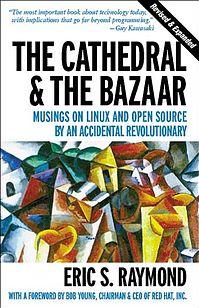The Cathedral and the Bazaar
 Cover of the paperback compendium edition | |
| Author | Eric S. Raymond |
|---|---|
| Publisher | O'Reilly Media |
Publication date | 1999 |
| ISBN | 1-56592-724-9 |
| OCLC | 42420737 |
| 005.4/32 21 | |
| LC Class | QA76.76.O63 R396 1999 |
| Followed by | Homesteading the Noosphere |
The Cathedral and the Bazaar (abbreviated CatB) is an essay by Eric S. Raymond on software engineering methods, based on his observations of the Linux kernel development process and his experiences managing an open source project, fetchmail. It examines the struggle between top-down and bottom-up design. It was first presented by the author at the Linux Kongress on May 27, 1997 in Würzburg and was published as part of a book of the same name in 1999.
Content
The essay contrasts two different free software development models:
- The Cathedral model, in which source code is available with each software release, but code developed between releases is restricted to an exclusive group of software developers. GNU Emacs and GCC are presented as examples.
- The Bazaar model, in which the code is developed over the Internet in view of the public. Raymond credits Linus Torvalds, leader of the Linux kernel project, as the inventor of this process. Raymond also provides anecdotal accounts of his own implementation of this model for the Fetchmail project.
The essay's central thesis is Raymond's proposition that "given enough eyeballs, all bugs are shallow" (which he terms Linus's Law): the more widely available the source code is for public testing, scrutiny, and experimentation, the more rapidly all forms of bugs will be discovered. In contrast, Raymond claims that an inordinate amount of time and energy must be spent hunting for bugs in the Cathedral model, since the working version of the code is available only to a few developers.
There are 19 steps to creating good open source software listed in his essay:
- Every good work of software starts by scratching a developer's personal itch.
- Good programmers know what to write. Great ones know what to rewrite (and reuse).
- Plan to throw one away; you will, anyhow.
- If you have the right attitude, interesting problems will find you.
- When you lose interest in a program, your last duty to it is to hand it off to a competent successor.
- Treating your users as co-developers is your least-hassle route to rapid code improvement and effective debugging.
- Release early. Release often. And listen to your customers.
- Given a large enough beta-tester and co-developer base, almost every problem will be characterized quickly and the fix obvious to someone.
- Smart data structures and dumb code works a lot better than the other way around.
- If you treat your beta-testers as if they're your most valuable resource, they will respond by becoming your most valuable resource.
- The next best thing to having good ideas is recognizing good ideas from your users. Sometimes the latter is better.
- Often, the most striking and innovative solutions come from realizing that your concept of the problem was wrong.
- Perfection (in design) is achieved not when there is nothing more to add, but rather when there is nothing more to take away.
- Any tool should be useful in the expected way, but a truly great tool lends itself to uses you never expected.
- When writing gateway software of any kind, take pains to disturb the data stream as little as possible—and never throw away information unless the recipient forces you to!
- When your language is nowhere near Turing-complete, syntactic sugar can be your friend.
- A security system is only as secure as its secret. Beware of pseudo-secrets.
- To solve an interesting problem, start by finding a problem that is interesting to you.
- Provided the development coordinator has a communications medium at least as good as the Internet, and knows how to lead without coercion, many heads are inevitably better than one.
Legacy
The essay helped convince most existing open source and free software projects to adopt Bazaar-style open development models, fully or partially — including GNU Emacs and GCC, the original Cathedral examples. Most famously, in 1998 it also provided the final push for Netscape Communications Corporation to release the source code for Netscape Communicator and start the Mozilla project.[1]
When O'Reilly Media published the book in 1999, it achieved another distinction by being the first complete and commercially distributed book published under the Open Publication License.
See also
Notes
References
- Eric S. Raymond (1999). The Cathedral & the Bazaar. O'Reilly. ISBN 1-56592-724-9.
